译林版(2019)必修 第三册Unit 3 The world on line Grammar and usage课件(33张)
文档属性
| 名称 | 译林版(2019)必修 第三册Unit 3 The world on line Grammar and usage课件(33张) | 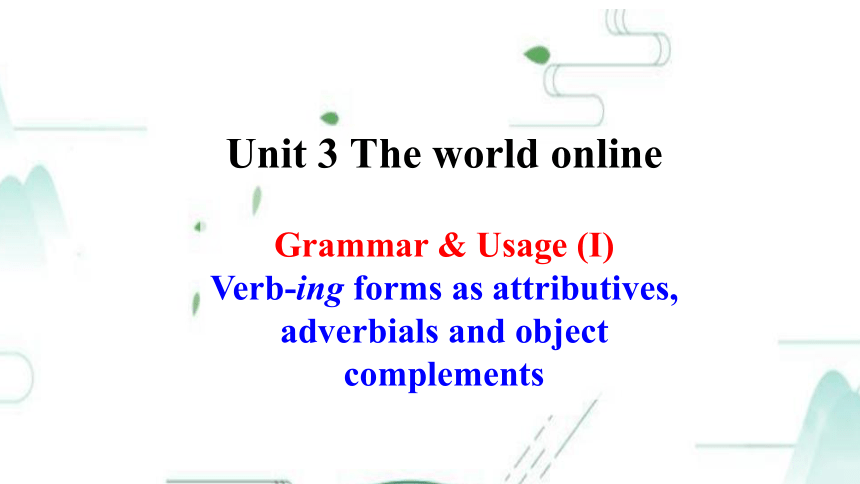 | |
| 格式 | pptx | ||
| 文件大小 | 1.3MB | ||
| 资源类型 | 教案 | ||
| 版本资源 | 牛津译林版(2019) | ||
| 科目 | 英语 | ||
| 更新时间 | 2024-04-21 10:26:58 | ||
图片预览

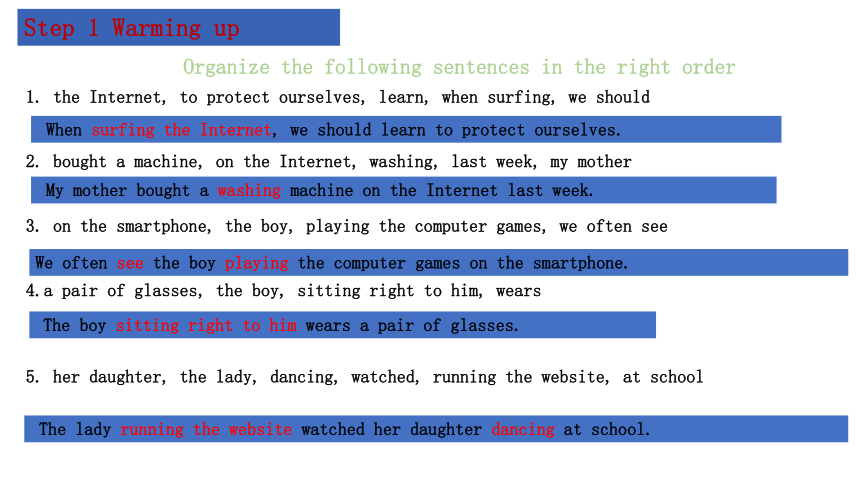
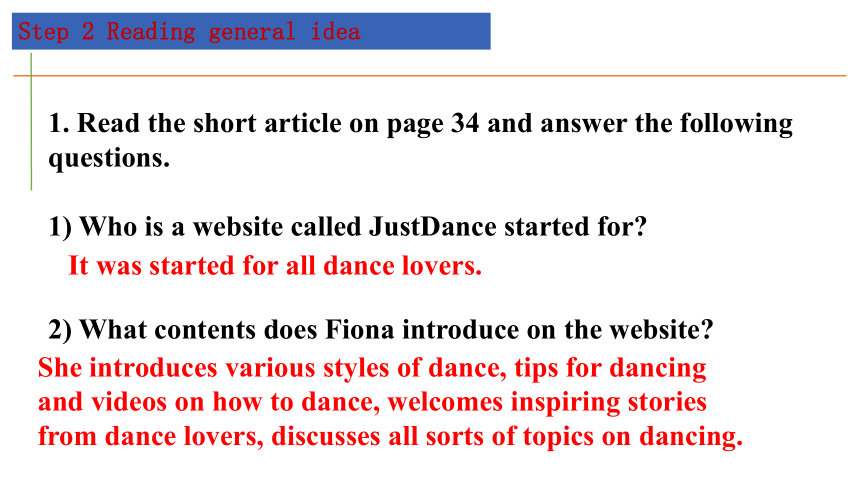

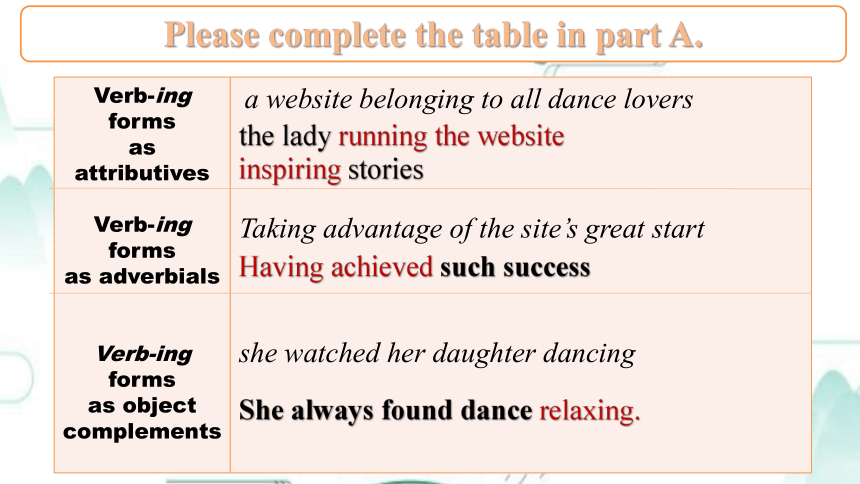
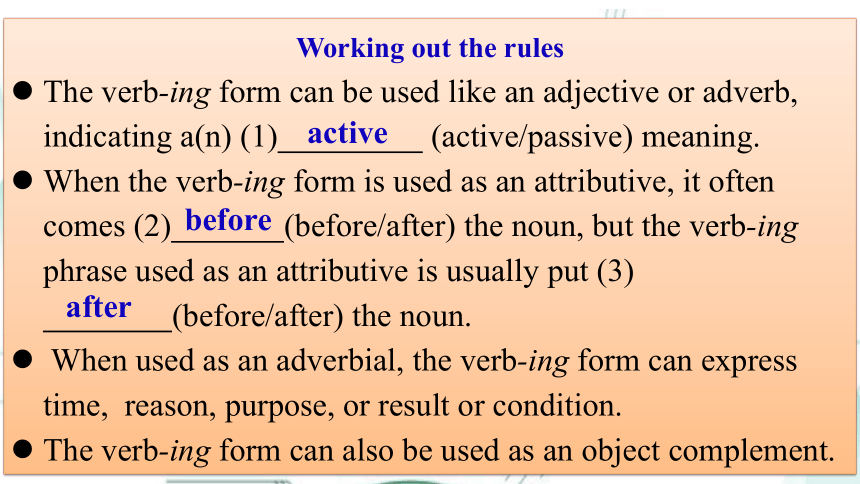

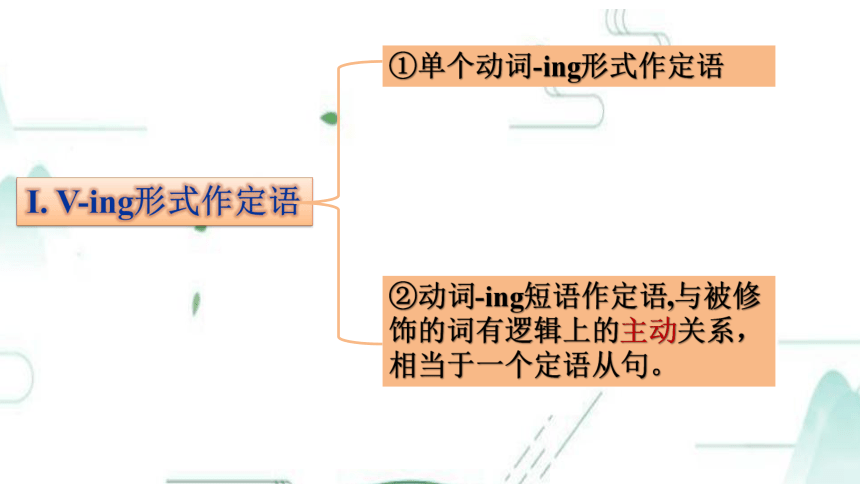
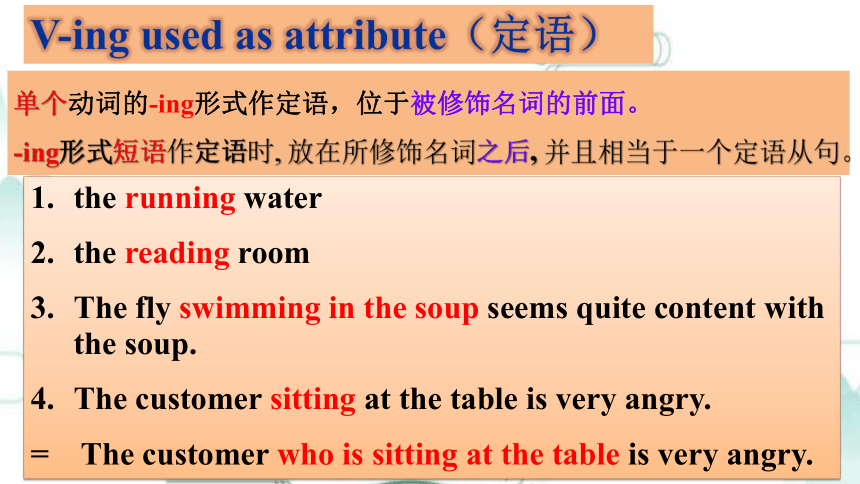
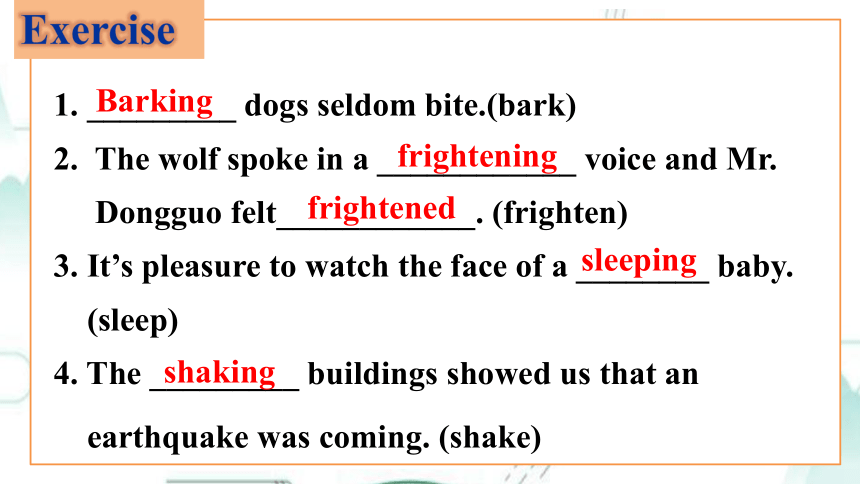

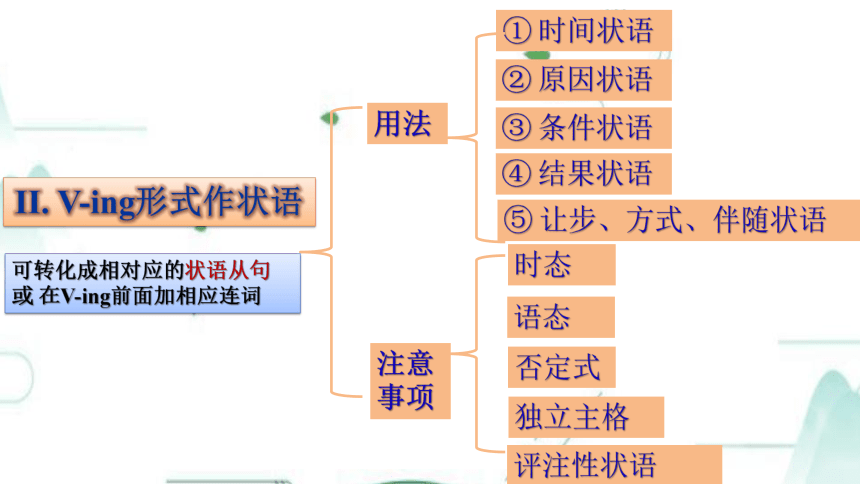
文档简介
(共33张PPT)
Unit 3 The world online
Grammar & Usage (I)
Verb-ing forms as attributives, adverbials and object complements
Step 1 Warming up
Organize the following sentences in the right order
1. the Internet, to protect ourselves, learn, when surfing, we should
2. bought a machine, on the Internet, washing, last week, my mother
3. on the smartphone, the boy, playing the computer games, we often see
4.a pair of glasses, the boy, sitting right to him, wears
5. her daughter, the lady, dancing, watched, running the website, at school
When surfing the Internet, we should learn to protect ourselves.
My mother bought a washing machine on the Internet last week.
We often see the boy playing the computer games on the smartphone.
The boy sitting right to him wears a pair of glasses.
The lady running the website watched her daughter dancing at school.
Step 2 Reading general idea
1. Read the short article on page 34 and answer the following questions.
1) Who is a website called JustDance started for
2) What contents does Fiona introduce on the website
It was started for all dance lovers.
She introduces various styles of dance, tips for dancing and videos on how to dance, welcomes inspiring stories from dance lovers, discusses all sorts of topics on dancing.
Read the website article on P34 and answer the following question.
Why did Fiona Lin set up the website JustDance
Because she wanted to introduce more people to dance since she had realized that dance had a very positive effect on her daughter.
Please complete the table in part A.
Verb-ing forms as attributives Verb-ing forms as adverbials Verb-ing forms as object complements a website belonging to all dance lovers
Taking advantage of the site’s great start
she watched her daughter dancing
the lady running the website
inspiring stories
Having achieved such success
She always found dance relaxing.
Working out the rules
The verb-ing form can be used like an adjective or adverb, indicating a(n) (1) (active/passive) meaning.
When the verb-ing form is used as an attributive, it often comes (2) (before/after) the noun, but the verb-ing phrase used as an attributive is usually put (3)
(before/after) the noun.
When used as an adverbial, the verb-ing form can express time, reason, purpose, or result or condition.
The verb-ing form can also be used as an object complement.
active
before
after
Go through “Grammar notes” from P99 to P100.
I. V-ing形式作定语
①单个动词-ing形式作定语
②动词-ing短语作定语,与被修饰的词有逻辑上的主动关系,相当于一个定语从句。
the running water
the reading room
The fly swimming in the soup seems quite content with the soup.
The customer sitting at the table is very angry.
= The customer who is sitting at the table is very angry.
V-ing used as attribute(定语)
单个动词的-ing形式作定语,位于被修饰名词的前面。
-ing形式短语作定语时, 放在所修饰名词之后, 并且相当于一个定语从句。
1. _________ dogs seldom bite.(bark)
2. The wolf spoke in a ____________ voice and Mr.
Dongguo felt____________. (frighten)
3. It’s pleasure to watch the face of a ________ baby.
(sleep)
4. The _________ buildings showed us that an
earthquake was coming. (shake)
Barking
frightening
frightened
sleeping
shaking
Exercise
ing形式作状语往往和逻辑主语之间存在主动关系,常常用来表示原因,时间,方式,结果,条件,伴随状况等。ing形式一般不作目的状语(通常用________作目的状语)。
V-ing used as adverbial(状语)
to do
II. V-ing形式作状语
① 时间状语
② 原因状语
③ 条件状语
④ 结果状语
⑤ 让步、方式、伴随状语
可转化成相对应的状语从句 或 在V-ing前面加相应连词
用法
注意事项
时态
语态
否定式
独立主格
评注性状语
Walking in the street, I came across an old friend of mine.
(=When I was walking in the street, I came across an old friend of mine.)
When I look at my classmates’ faces, I read the same excitement in their eyes.
(=Looking at my classmates’ faces, I read the same excitement in their eyes.)
1)作时间状语
V-ing used as adverbial(状语)
2) 作原因状语
Being ill, he didn’t go to school.
(=As he was ill, he didn’t go to school.)
Being a student, you should study hard.
(=Since you are a student, you should study hard.)
Thinking he might be at home, I called him.
(=As I thought he might be at home, I called him.)
3)表方式,伴随情况状语
作伴随状语的分词表示的动作,必须是主语的一个动作,或是与谓语所表示的动作(或状态)同时发生,或是对谓语表示的动词(或状态)作进一步地补充说明,此时它可转化成并列句。
He sat on the sofa, watching TV.
(=He sat on the sofa and watched TV.)
1.他们笑着谈着走进了教室。
____________________, they went into the classroom.
2. 他斜靠(lean)着墙站着。
He stood ________ against the wall.
(=He stood and leaned against the wall.)
Laughing and talking
Exercise
leaning
4) 表结果
Her mother died in 1990, leaving her with her younger brother.
(=Her mother died in 1990, and left her with her younger brother.)
全国到处在传唱这首歌曲,使它成了一首最受欢迎的歌曲。
The song is sung all over the country,
making it the most
popular song.
5)表条件
Using your head, you will find a way.
(=If you use your head, you will find a way.)
一直往前走,你就会看到一座白色地房子。
______________, you will see a white house.
Walking ahead
1. For a moment, I hesitated, not ___________ to rent him a room, but........ (want)
2. _________ (use) as a means of traffic in China, the bike is very useful.
3. The building____________over there now is our library. (build)
4. The blind man walked ___________ the walls of the buildings. (touch)
5. 我们都为即将到来的足球比赛感到紧张。
wanting
Used
being built
touching
We are all nervous about the coming football match.
Exercise
要注意各种形式变化:
主动形式 被动形式
动词-ing作状语
一般式
完成式
V-ing
being done
having done
having been done
听到铃声,学生们开始走进教室。
Hearing the bell, the students began to enter the classroom.
听见和进入两个动作同时相继发生
正在建造的大楼是我们的新图书馆。
The building being built now is our new library.
being built为现在分词的被动形式,表示动作正在进行之中。
完成了工作,他就回家了。
Having done the work, he went home.
一般式
完成式
V.-ing
having done
否定式
not +V.-ing not having+ done
动词-ing形式的否定式
他不知道这件事,所以没来。
_______________ (know) this, he didn’t come.
因为没有做好充足的准备,我们把运动会延期了。
________________ (make) full preparations, we put off the sports meeting.
Not knowing
Not having made
Exercise
独立主格结构
动词ing形式作状语,有时它也可以有自己的独立主语,这种结构称为独立主格结构,通常用来表示伴随的动作或情况,也可以表示时间,原因或条件。
那些树非常高,其中一些测量为90多米。
The trees are extremely tall, some over 90 meters.
由于天气好,我们去散步了。
The weather ,we went out for a walk.
being fine
measuring
一般来说
从……判断
从全盘考虑
e.g.从他的行为来判断,他一定是疯了。
动词 ing形式作评注性状语
有些动词 ing形式在句中没有逻辑主语,它们往往作为句子的评注性状语来修饰整个句子,表明说话者的态度,观点等。
generally speaking
judging by/from ...
taking everything into consideration
Judging from his behaviour, he must be mad.
①表感觉和心理状态的感官动词
see/hear/feel/smell…+sb +doing sth.
②使役动词“使,让”
have/let/keep…+sb/sth + doing sth.
III. V-ing形式作宾补
(1)表示感觉和心理状态的动词(感官动词),常见的有see, hear, feel,smell, find, notice, observe, look at, listen to等。
我感觉到有人拍了一下我的肩膀。
I felt somebody patting me on the shoulder.
你能闻到烧焦的味道吗?
Can you smell anything burning
我没有注意到他正在大门口等着。
I didn’t notice him waiting at the gate.
V-ing形式作宾补
(2)表示指使意义的动词(使役动词),常见的有have, set, keep, get, catch, leave等。
我不愿意让你一直做那件事。
I won’t have you doing that.
对不起,让你一直等了那么久。
I’m sorry to have kept you waiting.
我不能让钟表再运行了。
I can’t get the clock going again.
V-ing形式作宾补
Exercise
①He was last seen (play) by the river.
②When I entered the room, I saw him (try) on a new coat.
③They kept us waiting for a whole hour.(变为被动语态)
→We for a whole hour.
④I saw him put on his coat and walk out.(变为被动语态)
→He his coat and walk out.
playing
trying
were kept waiting
was seen to put on
C
Rewrite the following sentences using verb-ing forms.
The man operating the factory is concerned about the environment.
Walking straight down this road, you will see the post office on your right.
He sat there, not knowing what to say.
Not having finished his homework, he was punished by his teacher.
I find this job challenging.
Homework Checking
C
Rewrite the following sentences using verb-ing forms.
I noticed the man listening to music.
The bridge being built will shorten the driving distance between the two villages.
The factory keeps giving off smoke, polluting the air.
I appreciate your effort to help people living in poverty.
Waiting for the bus, I met an old friend of mine.
Homework Checking
Homework
Finish exercise B1, B2 on P35 ; C on P70
Unit 3 The world online
Grammar & Usage (I)
Verb-ing forms as attributives, adverbials and object complements
Step 1 Warming up
Organize the following sentences in the right order
1. the Internet, to protect ourselves, learn, when surfing, we should
2. bought a machine, on the Internet, washing, last week, my mother
3. on the smartphone, the boy, playing the computer games, we often see
4.a pair of glasses, the boy, sitting right to him, wears
5. her daughter, the lady, dancing, watched, running the website, at school
When surfing the Internet, we should learn to protect ourselves.
My mother bought a washing machine on the Internet last week.
We often see the boy playing the computer games on the smartphone.
The boy sitting right to him wears a pair of glasses.
The lady running the website watched her daughter dancing at school.
Step 2 Reading general idea
1. Read the short article on page 34 and answer the following questions.
1) Who is a website called JustDance started for
2) What contents does Fiona introduce on the website
It was started for all dance lovers.
She introduces various styles of dance, tips for dancing and videos on how to dance, welcomes inspiring stories from dance lovers, discusses all sorts of topics on dancing.
Read the website article on P34 and answer the following question.
Why did Fiona Lin set up the website JustDance
Because she wanted to introduce more people to dance since she had realized that dance had a very positive effect on her daughter.
Please complete the table in part A.
Verb-ing forms as attributives Verb-ing forms as adverbials Verb-ing forms as object complements a website belonging to all dance lovers
Taking advantage of the site’s great start
she watched her daughter dancing
the lady running the website
inspiring stories
Having achieved such success
She always found dance relaxing.
Working out the rules
The verb-ing form can be used like an adjective or adverb, indicating a(n) (1) (active/passive) meaning.
When the verb-ing form is used as an attributive, it often comes (2) (before/after) the noun, but the verb-ing phrase used as an attributive is usually put (3)
(before/after) the noun.
When used as an adverbial, the verb-ing form can express time, reason, purpose, or result or condition.
The verb-ing form can also be used as an object complement.
active
before
after
Go through “Grammar notes” from P99 to P100.
I. V-ing形式作定语
①单个动词-ing形式作定语
②动词-ing短语作定语,与被修饰的词有逻辑上的主动关系,相当于一个定语从句。
the running water
the reading room
The fly swimming in the soup seems quite content with the soup.
The customer sitting at the table is very angry.
= The customer who is sitting at the table is very angry.
V-ing used as attribute(定语)
单个动词的-ing形式作定语,位于被修饰名词的前面。
-ing形式短语作定语时, 放在所修饰名词之后, 并且相当于一个定语从句。
1. _________ dogs seldom bite.(bark)
2. The wolf spoke in a ____________ voice and Mr.
Dongguo felt____________. (frighten)
3. It’s pleasure to watch the face of a ________ baby.
(sleep)
4. The _________ buildings showed us that an
earthquake was coming. (shake)
Barking
frightening
frightened
sleeping
shaking
Exercise
ing形式作状语往往和逻辑主语之间存在主动关系,常常用来表示原因,时间,方式,结果,条件,伴随状况等。ing形式一般不作目的状语(通常用________作目的状语)。
V-ing used as adverbial(状语)
to do
II. V-ing形式作状语
① 时间状语
② 原因状语
③ 条件状语
④ 结果状语
⑤ 让步、方式、伴随状语
可转化成相对应的状语从句 或 在V-ing前面加相应连词
用法
注意事项
时态
语态
否定式
独立主格
评注性状语
Walking in the street, I came across an old friend of mine.
(=When I was walking in the street, I came across an old friend of mine.)
When I look at my classmates’ faces, I read the same excitement in their eyes.
(=Looking at my classmates’ faces, I read the same excitement in their eyes.)
1)作时间状语
V-ing used as adverbial(状语)
2) 作原因状语
Being ill, he didn’t go to school.
(=As he was ill, he didn’t go to school.)
Being a student, you should study hard.
(=Since you are a student, you should study hard.)
Thinking he might be at home, I called him.
(=As I thought he might be at home, I called him.)
3)表方式,伴随情况状语
作伴随状语的分词表示的动作,必须是主语的一个动作,或是与谓语所表示的动作(或状态)同时发生,或是对谓语表示的动词(或状态)作进一步地补充说明,此时它可转化成并列句。
He sat on the sofa, watching TV.
(=He sat on the sofa and watched TV.)
1.他们笑着谈着走进了教室。
____________________, they went into the classroom.
2. 他斜靠(lean)着墙站着。
He stood ________ against the wall.
(=He stood and leaned against the wall.)
Laughing and talking
Exercise
leaning
4) 表结果
Her mother died in 1990, leaving her with her younger brother.
(=Her mother died in 1990, and left her with her younger brother.)
全国到处在传唱这首歌曲,使它成了一首最受欢迎的歌曲。
The song is sung all over the country,
making it the most
popular song.
5)表条件
Using your head, you will find a way.
(=If you use your head, you will find a way.)
一直往前走,你就会看到一座白色地房子。
______________, you will see a white house.
Walking ahead
1. For a moment, I hesitated, not ___________ to rent him a room, but........ (want)
2. _________ (use) as a means of traffic in China, the bike is very useful.
3. The building____________over there now is our library. (build)
4. The blind man walked ___________ the walls of the buildings. (touch)
5. 我们都为即将到来的足球比赛感到紧张。
wanting
Used
being built
touching
We are all nervous about the coming football match.
Exercise
要注意各种形式变化:
主动形式 被动形式
动词-ing作状语
一般式
完成式
V-ing
being done
having done
having been done
听到铃声,学生们开始走进教室。
Hearing the bell, the students began to enter the classroom.
听见和进入两个动作同时相继发生
正在建造的大楼是我们的新图书馆。
The building being built now is our new library.
being built为现在分词的被动形式,表示动作正在进行之中。
完成了工作,他就回家了。
Having done the work, he went home.
一般式
完成式
V.-ing
having done
否定式
not +V.-ing not having+ done
动词-ing形式的否定式
他不知道这件事,所以没来。
_______________ (know) this, he didn’t come.
因为没有做好充足的准备,我们把运动会延期了。
________________ (make) full preparations, we put off the sports meeting.
Not knowing
Not having made
Exercise
独立主格结构
动词ing形式作状语,有时它也可以有自己的独立主语,这种结构称为独立主格结构,通常用来表示伴随的动作或情况,也可以表示时间,原因或条件。
那些树非常高,其中一些测量为90多米。
The trees are extremely tall, some over 90 meters.
由于天气好,我们去散步了。
The weather ,we went out for a walk.
being fine
measuring
一般来说
从……判断
从全盘考虑
e.g.从他的行为来判断,他一定是疯了。
动词 ing形式作评注性状语
有些动词 ing形式在句中没有逻辑主语,它们往往作为句子的评注性状语来修饰整个句子,表明说话者的态度,观点等。
generally speaking
judging by/from ...
taking everything into consideration
Judging from his behaviour, he must be mad.
①表感觉和心理状态的感官动词
see/hear/feel/smell…+sb +doing sth.
②使役动词“使,让”
have/let/keep…+sb/sth + doing sth.
III. V-ing形式作宾补
(1)表示感觉和心理状态的动词(感官动词),常见的有see, hear, feel,smell, find, notice, observe, look at, listen to等。
我感觉到有人拍了一下我的肩膀。
I felt somebody patting me on the shoulder.
你能闻到烧焦的味道吗?
Can you smell anything burning
我没有注意到他正在大门口等着。
I didn’t notice him waiting at the gate.
V-ing形式作宾补
(2)表示指使意义的动词(使役动词),常见的有have, set, keep, get, catch, leave等。
我不愿意让你一直做那件事。
I won’t have you doing that.
对不起,让你一直等了那么久。
I’m sorry to have kept you waiting.
我不能让钟表再运行了。
I can’t get the clock going again.
V-ing形式作宾补
Exercise
①He was last seen (play) by the river.
②When I entered the room, I saw him (try) on a new coat.
③They kept us waiting for a whole hour.(变为被动语态)
→We for a whole hour.
④I saw him put on his coat and walk out.(变为被动语态)
→He his coat and walk out.
playing
trying
were kept waiting
was seen to put on
C
Rewrite the following sentences using verb-ing forms.
The man operating the factory is concerned about the environment.
Walking straight down this road, you will see the post office on your right.
He sat there, not knowing what to say.
Not having finished his homework, he was punished by his teacher.
I find this job challenging.
Homework Checking
C
Rewrite the following sentences using verb-ing forms.
I noticed the man listening to music.
The bridge being built will shorten the driving distance between the two villages.
The factory keeps giving off smoke, polluting the air.
I appreciate your effort to help people living in poverty.
Waiting for the bus, I met an old friend of mine.
Homework Checking
Homework
Finish exercise B1, B2 on P35 ; C on P70
同课章节目录
- Unit 1 Nature in the balance
- Welcome to the unit
- Reading
- Grammar and usage
- Integrated skills
- Extended reading
- Project
- Unit 2 Natural disasters
- Welcome to the unit
- Reading
- Grammar and usage
- Integrated skills
- Extended reading
- Project
- Unit 3 The world online
- Welcome to the unit
- Reading
- Grammar and usage
- Integrated skills
- Extended reading
- Project
- Unit 4 Scientists who changed the world
- Welcome to the unit
- Reading
- Grammar and usage
- Integrated skills
- Extended reading
- Project
